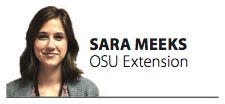
Microwave meals come in handy this time of year. It’s comforting to have warm food on a cold day and microwave cooking is a quick and easy way to make a meal.
Microwave ovens don’t have to be used only for premade frozen meals or reheating leftovers. In fact, homemade, nutritious dishes can be made in a microwave oven without much effort.
How microwave ovens cook food
Microwave ovens cook food by converting electricity to short waves of energy similar to radio waves. These waves are absorbed by water, fats and sugars, and vibrate very fast to create thermal (heat) energy and high temperatures that cook food.
How to successfully cook a variety of foods in a microwave oven
Microwave ovens can cook at different power levels. Naturally, not all foods cook the same, so using just one power level for every type of food doesn’t make sense. Check your owner’s manual to find out how to change your microwave oven’s power level.
High power (100%) can be lowered to medium power (50%), which means the microwave oven cycles off and on, producing microwaves 50% of the time and off 50% of the time.
Tender foods and those with a high moisture content like ground beef, poultry, vegetables and fruit can be cooked on high power. Foods like eggs, cheese, and solid meat, especially large cuts of meat, should be cooked on medium power for longer periods. Cooking on medium power for a longer time allows heat to better reach the center of the food without overcooking outer areas.
How to tell if food is cooked to a safe temperature
Ensuring food is safe to eat is important whether you’re cooking, defrosting, or reheating. Have a food thermometer on hand to verify food reaches the correct temperature for food safety:
-
Ground meats 160 degrees
-
Fresh beef, pork, lamb, veal, chops, roasts 145 degrees
-
Poultry 165 degrees
-
Eggs and egg dishes 160 degrees
-
Fish 145 degrees
How to defrost food in a microwave oven
Microwaves are a safe, fast way to defrost food. Defrost and cook large cuts of meat and other frozen foods on medium power (50%) rather than high power (100%) because this allows heat to reach the center of food without making outer areas tough and dry.
Use the defrost setting if your microwave has one, otherwise, defrost foods at 30-50% power. When finished defrosting in a microwave oven, do not let food sit, finish cooking right away. Harmful bacteria grow rapidly in the temperature danger zone (40-140 degrees).
How to safely reheat cooked food
Microwave ovens are often used to reheat leftovers, and eating leftover food has a great benefit – cook once, eat twice! It’s important to make sure cooked food is reheated to the right temperature for food safety. That temperature is 165 degrees for leftover food.
For more information about microwave oven cooking, check out the United States Department of Agriculture handout on Microwave Ovens and Food Safety.
Interested in attending a class to learn more about making easy homemade meals in the microwave? Ohio State University Extension Wayne County is offering a series of three classes on Thursdays in February at noon located in the Wayne County Extension office.
On Feb. 3 we will share simple breakfast recipes. Feb. 10 will cover easy one dish meals. The final class on Feb. 17 will share smaller portion recipes for one or two people. Attend one class or all three to learn how to make quick and easy microwave meals.
The series has a fee of $10. Those interested should register by Feb. 1 at go.osu.edu/microwavemeals.
Sara Meeks is an OSU Extension Family & Consumer Sciences Program Assistant and may be reached at 330-264- 8722.
This article originally appeared on The Daily Record: Microwaved meals are as easy as 1, 2, 3, and good tasting, too




More Stories
Dated Kitchen Features That Homebuyers Notice
Shake the fridge Shakshuka using up leftovers
Italian Meatloaf – Once Upon a Chef